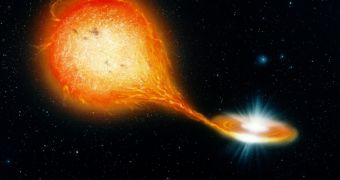Researchers at the University of Colorado in Boulder (UCB) and the University of Oxford, in the United Kingdom, announce the most compelling evidences to date supporting the existence of cosmic oddities called Thorne-Zytkow objects. These formations were hypothesized to exist long ago.
California Institute of Technology (Caltech) astrophysicist Kip Thorne and University of Cambridge astrophysicist Anna Zytkow were the first to propose the existence of cosmic structures that now bear their names, nearly 40 years ago. The recently-found object is the strongest candidate found to date.
In theory, a Thorne-Zytkow object would consist of a dying star with a bloated atmosphere, featuring an ultradense and relatively small neutron star at its core. One possible formation mechanism for such a structure would be that a dying massive star engulfed a neutron star, inside a formerly-binary system.
Binary systems are not at all uncommon in the Universe. They usually consist of two stars, but may contain black holes, neutron stars, relapsing novae and other cosmic objects. In some cases, the two bodies either destroy each other, or one is engulfed by the other.
For example, a binary system featuring a regular star and a black hole will feature the latter slowly channeling matter off the former, until it is entirely consumed. Thorne and Zytkow hypothesized in 1975 that cases may exist where neutron stars are gulped up by massive, dying stars, creating cosmic oddities with extreme behaviors.
Over nearly four decades, a number of candidates for a Thorne-Zytkow object have been proposed, but none stood up to rigorous scientific scrutiny. On Monday, January 6, the UCB/Oxford team presented a new proposal at the 223rd annual meeting of the American Astronomical Society (AAS), in Washington, DC.
The potential candidate was uncovered during a survey conducted with the Magellan telescopes in Chile, which centered on 22 red supergiant stars. One such star was discovered in the dwarf galaxy Small Magellanic Cloud – a satellite of the Milky Way – were elements such as rubidium, lithium and molybdenum exist.
According to predictions made by Thorne and Zytkow, these chemicals should be found in abundance inside the weird objects they predicted. This is largely due to the fact that such a cosmic structure would not conduct nuclear fusion in the regular manner, Nature News reports.
“What we found is the most compelling observational evidence for this model of stellar interior,” explained the leader of the new survey, UCB astronomer Emily Levesque. She did not agree to disclose the name of the red supergiant in question, since the findings have not yet been published in a journal
“The object is an excellent candidate, although it is perhaps not an open-and-shut case,” concluded Oxford stellar astrophysicist Philipp Podsiadlowski, the leader of the British participation in the study.

 14 DAY TRIAL //
14 DAY TRIAL //